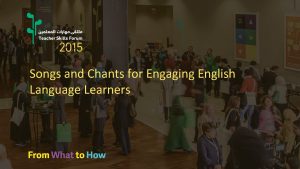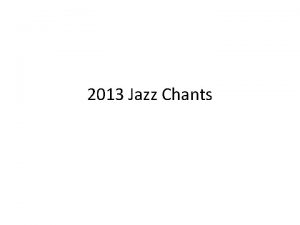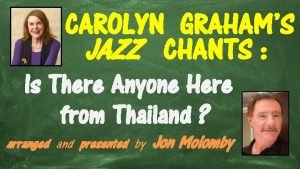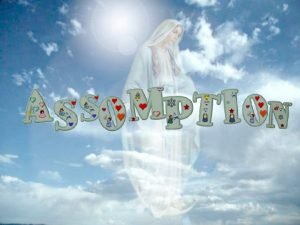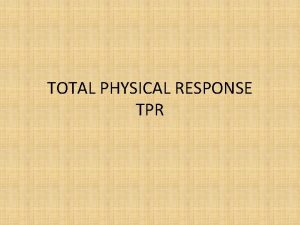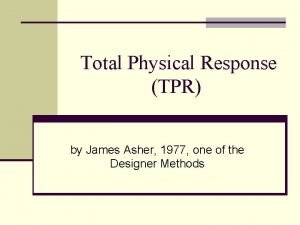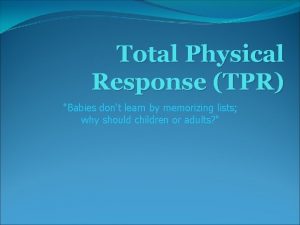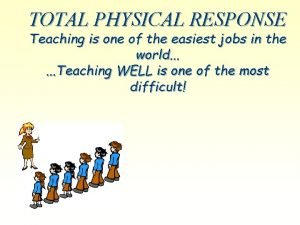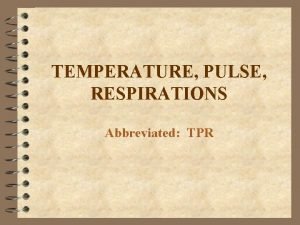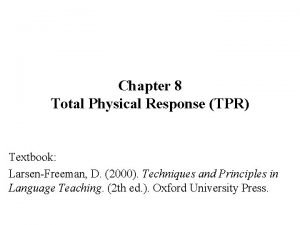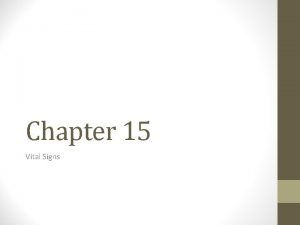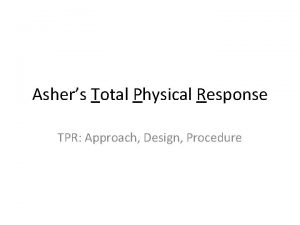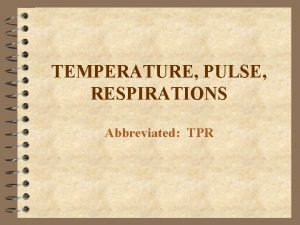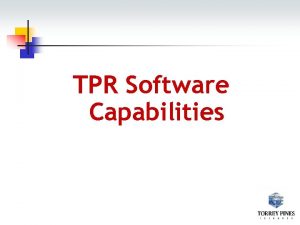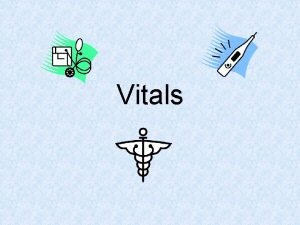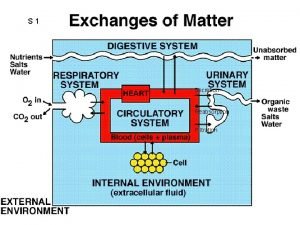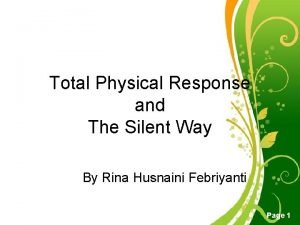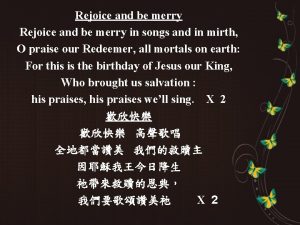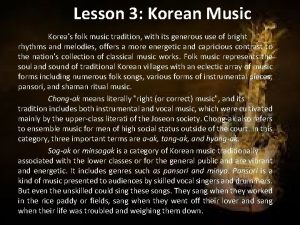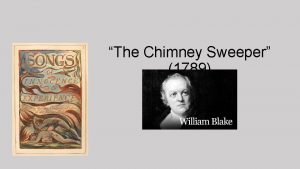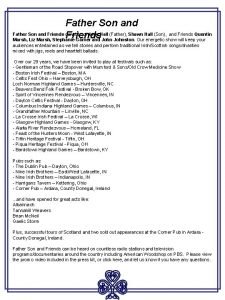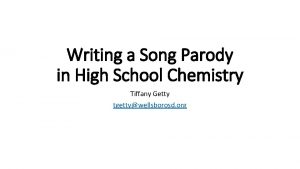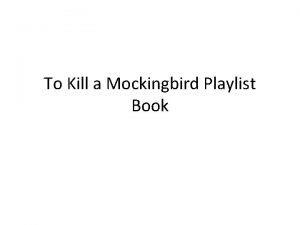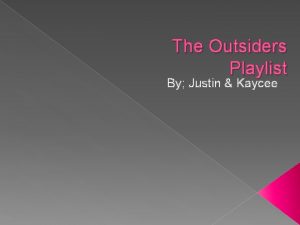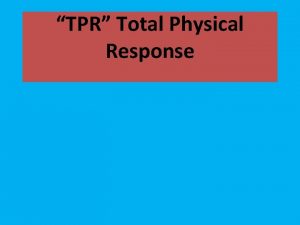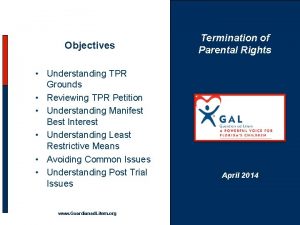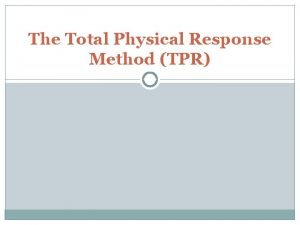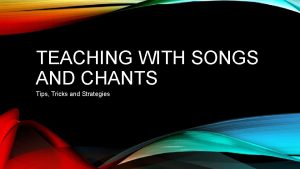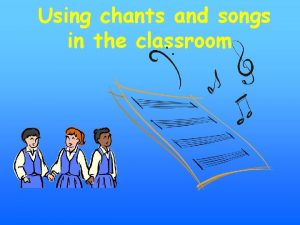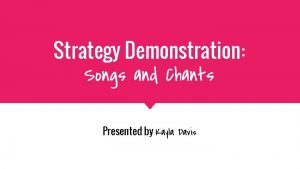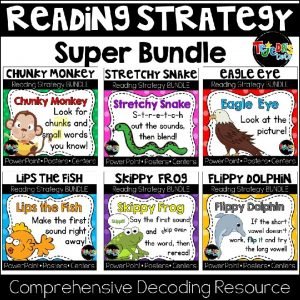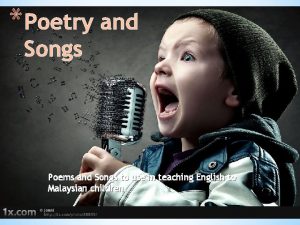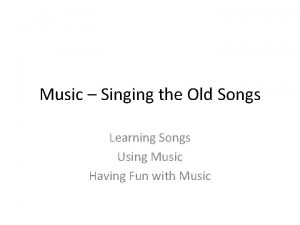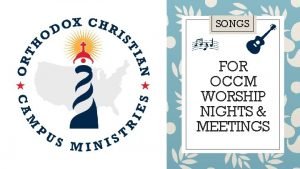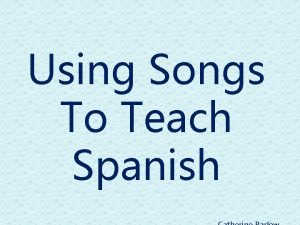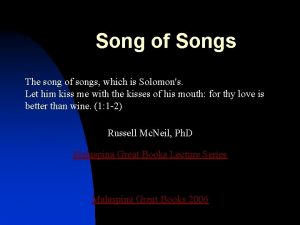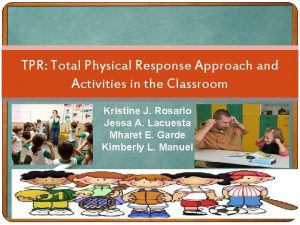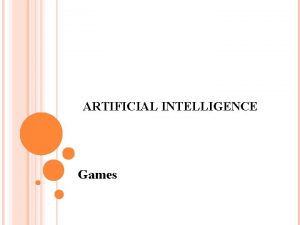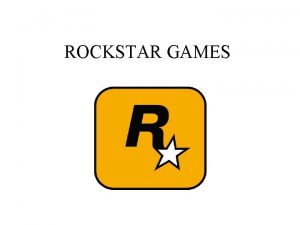Songs and chants TPR activities Games Qs and
















































- Slides: 48














课堂教学活动形式 -外在 Songs and chants TPR activities Games Qs and As (T-S; T-Ss; T-G; S-Ss; Ss-S) T presenting new language Listening to the tape Repetitions Reading aloud Pair/group presentations (role plays) Whole-class feedback











课堂学习效果分析- 案例五(三年级) T: Now, follow me. Behind. Ss. Behind. (Repeat after the T three times) T. Behind the teacher. Ss Behind the teacher. (Repeated three times) T. Behind Ss. Behind. T. Behind ↗ Ss. Behind↗ T. behind↘ Ss. behind↘ T. Behind the teacher. Ss Behind the teacher (Repeat again) T. Where is xxx? Ss. She is behind the teacher. T. Behind the teacher. Ss Behind the teacher. T. Behind Ss Behind. T. Behind↗ Ss. Behind↗ T. Behind↘ Ss. Behind↘ T. Behind the teacher. Ss Behind the teacher. (Repeated again) T. Where is xxx? Ss. She is behind the teacher. T. Where is xxx? Ss 1. Behind the teacher. T. Where is xxx? Ss 2. Behind the teacher. T. Where is xxx? Ss 3. Behind the teacher. T. Where is xxx? Ss 4. behind the teacher. T. Where is xxx? Ss 5. Behind the teacher.

课堂学习效果分析-教师提问 -开放性问题 T: What’s your favourite toy, Joy? S: My favourite toy is (. . ) dog. T: Because …(Waiting) S: Because (. . ) dogs are beautiful. T: Thank you. Whose favourite toy is boat? Ss: My favourite toy is boat (. ) because boats can (. ) flow on water T: boats can flow on water (children followed the T and said it with actions)

教师提问 -开放性问题 1. 2. 3. 4. 5. 6. 7. 8. 9. 10. 11. 12. 13. 14. 一年级 T: I have a lot of ‘clothes’ here. (T shows some pictures of different kinds of clothes. Ss: Wow (showing surprise and interests) T: I know ‘skirt’, what clothes do you know? S 1: I know [? ? ] T: Louder, please. S 1: I know a cap. T: Thank you, David. S 2: I know ‘T-shirt’. T: Oh, you know ‘T-shirt’. S 3: I know ‘jacket’. T: Good job, Benson. Very loud voice! Joe? S 4: I know (. . ) jacket. T: Oh, you know jacket, too.

教师提问 – 开放性问题 T. Now, what’s your favourite month? (Repeated three times) S 1. My favourite month is April. T. Why? S 1. April is my birthday. T. OK. Your birthday is in April, right? T. What’s her favourite month? Ss. Her favourite month is April. T. What’s your favourite month? S 2. My favourite month is June. T. Why? S 2. Because it’s Children’s Day. T. Oh, because children’s day is in June. T. What is your favourite month? 二年级 S 3. My favourite month is January. T. Why? S 3. Because my father’s birthday is in January. T. You know what is my favourite month? Guess. S 4. January? T. January? No. S 5. April? T. Yes, of course. My favourite month is April. Ss. Why? T. Do you know why? S 6. It’s your birthday! T. Yes. My birthday is in April so I like April very much.

学生提问 ¡ ‘Guessing games’ ‘Question time’ Children ask and answer using cues provided by the teacher. Information gap activities, role-plays, and interviewing activities in which children need to ask questions to do the tasks. Using context or pictures to invite questions from the children.

学生提问 三年级 & 四年级 ¡ T. Let’s look. Hello! (T takes out a caterpillar from behind the desk. Children are laughing and look excited). (Caterpillar) I like you! ¡ Ss. I like you, too. ¡ T. (Caterpillar) I want to make friends with you. Do you have questions? ¡ S 2. What’s your name? ¡ T. Oh, what’s my name? I don’t have an English name. Can you give me a name? An English name. ¡ S 2. Peter! ¡ T. Peter? But I am a girl. ¡ S 3. Lulu. ¡ T. Wah, Lulu. Thank you. Lulu is a nice name. OK. My name is Lulu. ¡ S 4. Good morning, Lulu. ¡ T. (Caterpillar) Ok, now, Let’s shake hands. (Children were laughing) ¡ S 5. What color do you like? ¡ T. (Caterpillar) Blue…, yellow…green. ¡ S 6. How old are you? ¡ T. (Caterpillar): I’m 2 years old. … ¡T. … 805 years ago. We are going to talk about life in the past. Now, let’s look at the Castle. Do you have any questions about the life then? Any questions? Harry. ¡S 21. How did they cook? ¡S 22. They cooked by open fire. ¡T. T. Oh, they cooked by open fire. Any more questions? ¡S 23. How did they a have a bathroom? ¡T. Have a bath. OK. …. (T explains and presents two new words ‘wooden tub’ and ‘ bathtub’. Any more questions? ¡S 24. How did they travel? ¡S 25 They traveled by horse. ¡T. Yes, very good! Any more questions? ¡S 28. How did they eat? ¡S 29. They ate by hand. ¡S 30. Why do they use candles? ¡S 31. Because they had no electric light.








关于教学目标的表述(例五) 1. Language knowledge Names of jobs: photographer, saleswoman, film director, etc. Verbs describing daily activities: work out, take photos, sell clothing, etc. 2. Language use By the end of the lesson, students should be able to: understand different jobs and their job routines; introduce oneself: name, job, and daily job routines; ask about other people’s favorite pastimes and tell how often one does certain activities 3. Moral instructions Spend your free time wisely










wang_qiang 99@yahoo. com
 Language
Language Cinderella dressed in yellow jump rope song
Cinderella dressed in yellow jump rope song You did it again jazz chant
You did it again jazz chant Hudhud chants of the ifugao threats
Hudhud chants of the ifugao threats Carolyn graham jazz chants
Carolyn graham jazz chants Chants à marie
Chants à marie Types of games indoor and outdoor
Types of games indoor and outdoor What thought angers katniss (p. 167)?
What thought angers katniss (p. 167)? Indoor sports and outdoor sports
Indoor sports and outdoor sports Support activities and primary activities
Support activities and primary activities Primary and secondary activities
Primary and secondary activities Operating activities vs investing activities
Operating activities vs investing activities Co=map/tpr
Co=map/tpr Pulse sites on the body
Pulse sites on the body Tpr recording chart
Tpr recording chart Introduction of tpr
Introduction of tpr Asher 1977
Asher 1977 Tpr example
Tpr example What is tpr in teaching
What is tpr in teaching Abbreviation for temperature pulse and respiration
Abbreviation for temperature pulse and respiration What is tpr in teaching
What is tpr in teaching Chapter 16:1 measuring and recording vital signs
Chapter 16:1 measuring and recording vital signs Chapter 16:1 measuring and recording vital signs
Chapter 16:1 measuring and recording vital signs Procedure of tpr method
Procedure of tpr method What does prom stand for
What does prom stand for Measuring and recording apical pulse
Measuring and recording apical pulse Tpr simon says
Tpr simon says Tpr thesis statement
Tpr thesis statement Tpr temperature pulse respiration
Tpr temperature pulse respiration Similar polygons example
Similar polygons example Fetal heart
Fetal heart Tpr software
Tpr software Tpr chart medical
Tpr chart medical Tpr 430
Tpr 430 Graphing tpr
Graphing tpr Apical radial pulse
Apical radial pulse 2009 delmar cengage learning
2009 delmar cengage learning Co = hr x sv
Co = hr x sv Thank you in powerpoint
Thank you in powerpoint Rejoice and be merry in songs and in mirth
Rejoice and be merry in songs and in mirth Remember to or ing
Remember to or ing Paperless hymnal
Paperless hymnal Used in both the folk and classical music of korea
Used in both the folk and classical music of korea The chimney sweeper songs of innocence
The chimney sweeper songs of innocence Father son and friends
Father son and friends Cfc glory songs chipstenoso
Cfc glory songs chipstenoso How to write a song parody
How to write a song parody To kill a mockingbird playlist
To kill a mockingbird playlist Songs that relate to the outsiders
Songs that relate to the outsiders
